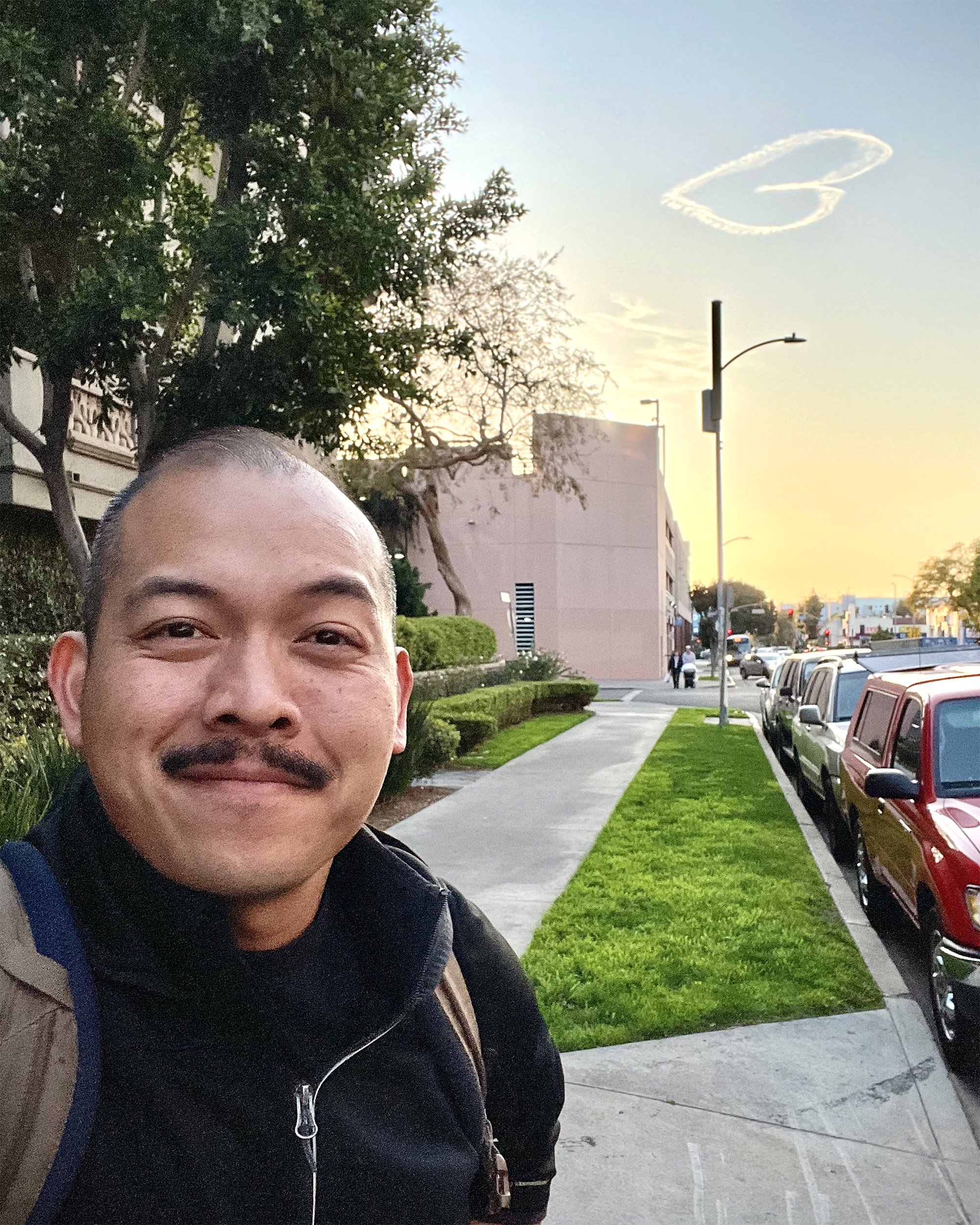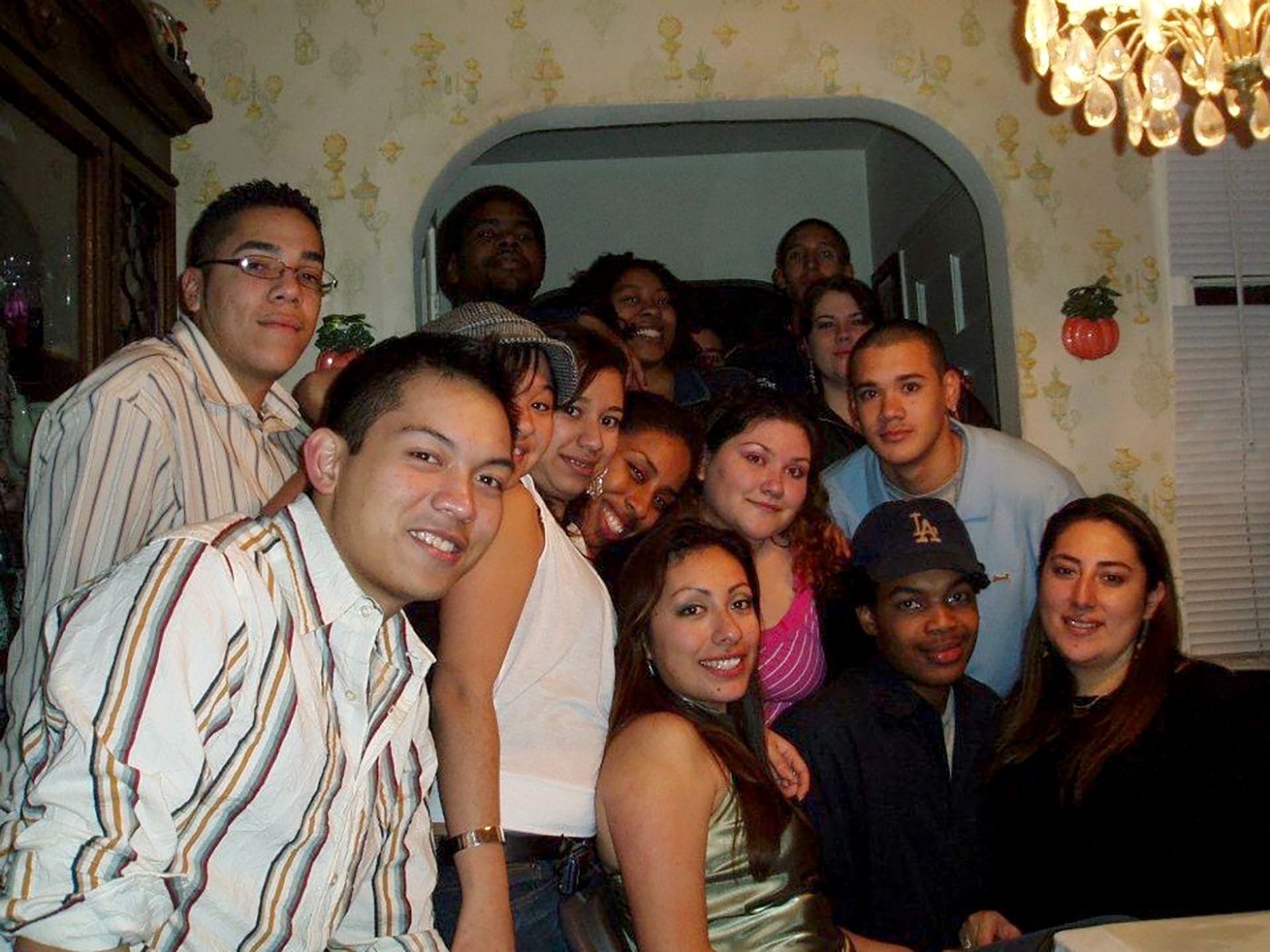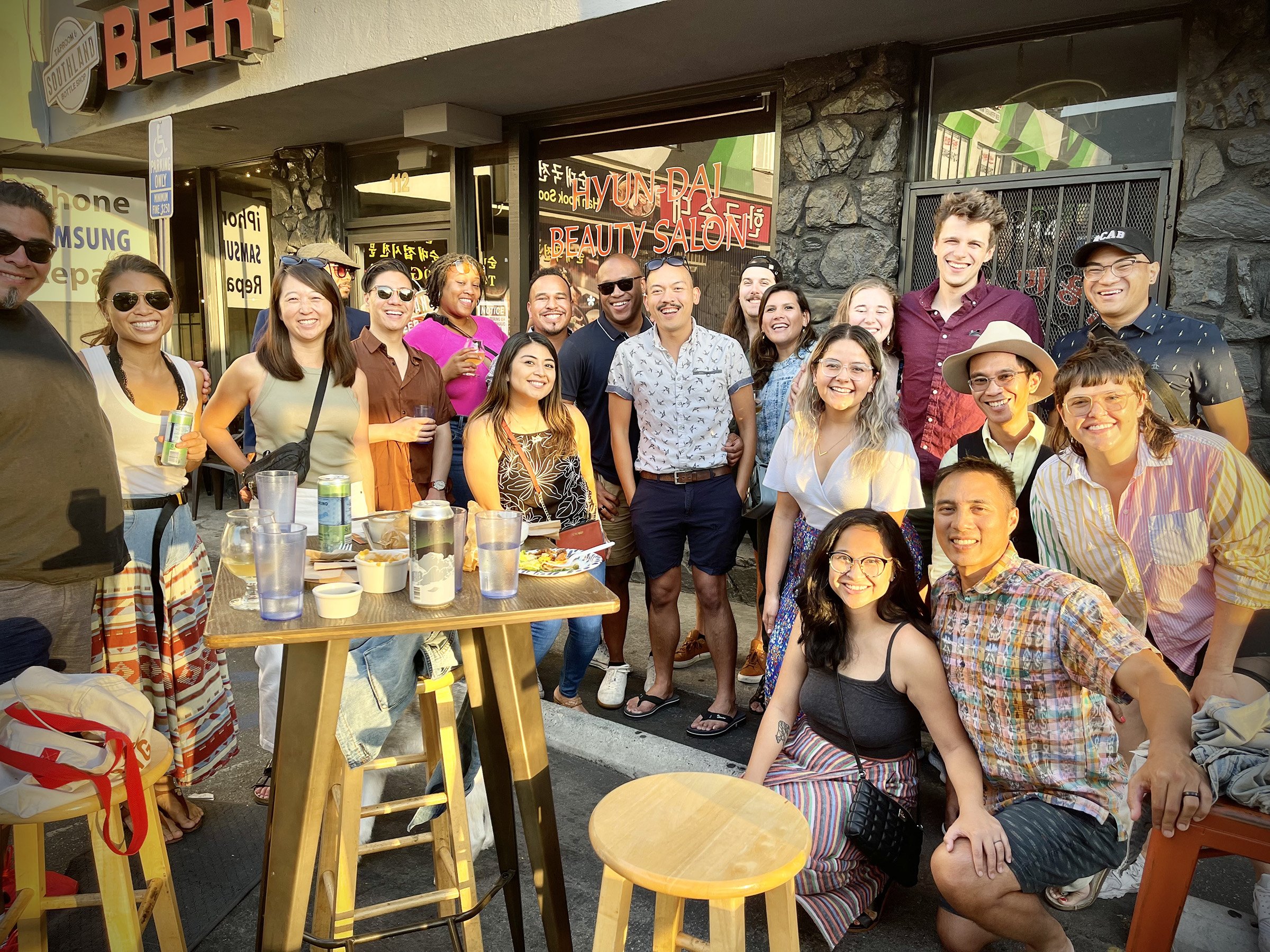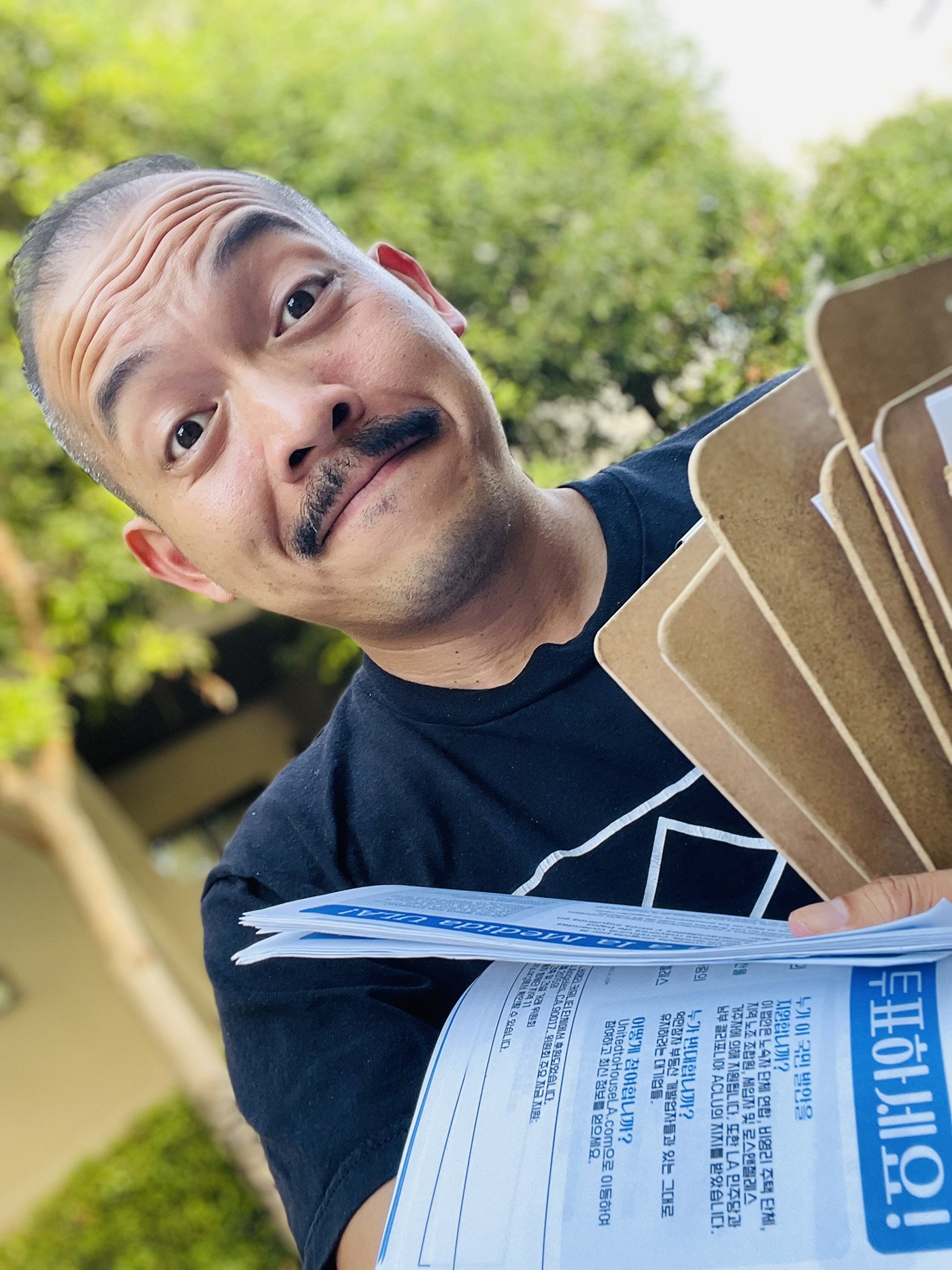Godfrey Santos Plata: As Koreatown Goes, so Goes Los Angeles
Godfrey is a queer Filipino immigrant, a renter in Koreatown, a former candidate for the California State Assembly’s 53rd District (which is now the 54th), and, most recently, an organizer with LA Forward. He notes the major questions that planners should consider for the future of K-Town, including whose voices should take priority over more housing and amenities.
This interview has been edited for length, flow, and clarity. Photos provided by Godfrey Santos Plata.
Jimmy: I've got a handful of questions about this special place known as K-Town, which you are a fundamental part of.
Godfrey: Aw, thanks!
Jimmy: First of all, what comes to mind when you think of this neighborhood, this community?
Godfrey: I mean, I think “community” is a really important place to start. It’s the people. Two words that came to my mind when you asked me that question are “diversity” and “density.” I think those two things describe everything we have to offer but also the challenges that Koreatown faces. What we know about Koreatown is that it’s an amalgamation of so many different communities. Not only are there long-standing Central American communities and the Korean community, we know that, historically, there was a Jewish migration through here as well that eventually moved out west. And then, today, what we readily see—because of so many of the restaurants and bars—is that this is also often the place where people who are not from California or Los Angeles end up landing. And so it’s this really interesting mix of old and new all the time in a densely populated, three-square-mile area. It's the most dense area west of the Mississippi. People think of New York City in terms of density, and we probably approximate that here in Koreatown.
What that means for me as a resident is that I love walking to everywhere that I need to go or taking public transportation to go everywhere I need to go.
But, you know, going back to the challenges of diversity and density, it also means we don't have enough housing for all of our neighbors. In the shadows of new buildings that are rising all the time to attract people moving to California for the first time, we are not accommodating people who have been living here for decades but can’t afford the rent. So that means that there are major tensions in imagining what the future of Koreatown is and who it's for.
Jimmy: That's absolutely right. But before we meditate further on the future, I want to ask what is one of your earliest memories in or through K-Town?
Godfrey and his sister in their toddler years singing at their Gardena home soon after first arriving to the U.S.
Godfrey: When I immigrated to the U.S. from the Philippines, my family landed in the South Bay, in the Gardena/Carson/Compton area. So my first memories of Koreatown are actually on the news, following the beating of Rodney King by four police officers. We all watched it. It's probably one of my first memories of video-captured police violence. And then we know what happened when the four officers were acquitted. That sort of unleashed a lot of tension about the different racial structures that created certain realities for particular racial groups, but also between different racial groups. So my first memories of Koreatown are Koreatown on fire.
Jimmy: Wow.
Godfrey: Koreatown populated with cars in the middle of the street, people hiding behind cars with guns or to avoid gunshots. These are my first memories of Koreatown as a child, having moved to the United States.
My parents actually don't know this but after I learned how to drive, I had an “opportunity” with the family car one day. Normandie, Western, and Vermont all pass through Gardena. So I just followed Western all the way up, which actually leads to exactly where I live today, right off of Western. It's really interesting to have lived on both sides of Western in my journey through Los Angeles. As an adolescent driving up this way to Koreatown, the density was attractive. There was so much stuff happening here that made it feel like a city, versus a place like Gardena where my parents settled because it was affordable and it was close to a lot of Filipino things down there near Carson. It was just a little bit… Well, it wasn’t this.
Jimmy: So you're saying that, after those early years seeing K-Town on fire, you also bore witness to the further development and densification of K-Town, and that actually called out to you as a young person who wanted to find some hip things to do at that point in your life.
Godfrey: Yeah. I mean, when I was growing up, I didn't have a lot of permission to spend time in the way that I wanted to. And that's why when I had the opportunity to actually make decisions on my own, I was curious about the things that my family wouldn't make the choices to do.
My family would rather preserve a lot of cultural comforts, like what restaurants they knew, what malls they knew in the South Bay. I was itching for something different, and there was something that was beckoning about Koreatown.
Godfrey with high school friends reuniting after graduation in 2002.
Jimmy: And just like you said, all you had to do was—
Godfrey: Literally go north on Western. And you see so much of the city, right? Just along any of those streets: Vermont, Normandie, or Western. That's a podcast in and of itself, just to drive down those streets.
Jimmy: Yeah, those are absolutely core avenues for the city of Los Angeles, especially Central Los Angeles. You’ve sort of already spoken about it up to a point, but I'm curious about one key strength that you see in K-Town and then one drawback or shortcoming.
Godfrey: What a hard question! There are so many things I want to say about both strengths and challenges, but I'll go back to the first things that came to me: diversity and density. I do think those are strengths, not just for Koreatown but for Los Angeles as a whole. The reality is that LA will see more density. And the diversity and the pedestrian ways in which we can live life in Koreatown—where we have our schools, churches, public transportation, restaurants, bars, everything within walking distance—is a reality that could exist for other parts of Los Angeles.
We can imagine what that could look like through the way we get to do it here. As a Filipino, I love eating. I love food and I love being around lots of different types of celebrations, and in Koreatown, there's no shortage of events on weekends that are popping up all the time. And people actually come to Koreatown on the weekends because of this, right? So the density and energy don't serve just those of us who live here. They’re attractive and they boost an economy. I think there's an imaginative possibility in the density and diversity for something really cool that can move Los Angeles forward. And yet people are scared of density, they're scared of what that does.
Godfrey and an array of friends celebrating a birthday at Southland Beer in Koreatown.
I think it's rightful to be scared of density when it pushes out folks who have made their lives and home here. You know, we are sitting at a coffee shop right now where we're overlooking a parking lot, rather than a home or units of homes. There are a lot of land use questions when you have density, and it depends who owns that property. Is it publicly owned? If so, what say do the neighbors have? Then there are lots of cost-related questions that come into mind with density. A lot of safety questions, too. So I think that there are challenges in terms of land use, and a part of those challenges are also environmental. I mentioned the pedestrian nature of Koreatown, and I think I did that intentionally to open up our imagination to what that means environmentally.
One of my wishes for Koreatown is that we have more green space, which is also really hard to realize in a densely-populated area that’s reserved primarily for housing and business. We want green space that serves the hundreds of thousands of people who deserve that. There's so many families being raised here. But where do you put the green space when you're balancing that with priorities of housing?
Jimmy: You know, I think of Central Park in New York as an example of balancing density and green space, how the two don’t have to be in such conflict.
Godfrey: They don't… Because of the political work I've done in the area, something that I've come to peace with is the fact that you're never going to please everybody. I think we always have to choose who is the core compass for the decision-making for a particular neighborhood. Who's at the center? And right now in Koreatown, a lot of that center is the potential future tenant of Koreatown who doesn’t even know they’re going to move here yet, as opposed to the people who are here all the time.
I’m lucky to be in rent-control housing. As I mentioned, I love being able to walk everywhere. And there are establishments I frequent, in particular, a plaza at 740 South Western. There's like a bar there for beer, there's a ramen place, a boba place… It's just this place that I can walk to.
Recently, they were bought out by Jamison Properties, one of the biggest developers out here. And I think I would be more willing to say that that’s okay if I knew that 100% of that was going to go to affordable housing, because that's actually what we need. But the reality is, in that building that’s going to have about 140 units or so, about 11 are going to be for affordable housing.
Jimmy: So, 10%?
Godfrey: Yeah, 10%. That’s the requirement to access permission for that development to happen. That sucks, right? We haven't centered the community that is currently here in making that decision. We're centering the possible profit that could be made. When I talked with those business owners, they hadn't been reached out to by the city to figure out what their next steps are. Where would their businesses go after this? What's their recourse? Not only are we displacing tenants who could remain here in Koreatown, we're displacing businesses and people's livelihoods that allow them to stay in the area too. So there's this ripple effect.
You know, when you mentioned Central Park earlier, I agree. I would love a vision like that for Los Angeles. But something I've learned on my visits to New York is that some of that park has also displaced Black and Indigenous communities, especially on the northern side. And I’m sure there are even more stories that I don’t know. That's what we're trying to figure out here, right? Like, what would a community vision for 50 years down the line look like for us? I'm glad Central Park helps us imagine what could be possible. But at some point, there was some sort of cost benefit at the start of the planning, right?
Jimmy: I think what you're alluding to is actually taking into account the legacies in the city of Los Angeles up to this point, and not pointing to some arbitrary place on the map and going, “Development can be placed here.” No, actually, there's a legacy to honor. There's a whole history of how the neighborhood came to be formed. And to just wipe that off is to lose culture, history, and what equity is supposed to look like in the 21st Century. So what we’re really talking about is honoring and honing in on the story here.
Godfrey: Yeah, and I think we have to be intentional about that. There's an organization in L.A. that is trying to move toward what's called a capital infrastructure plan, or CIP. And the state actually mandates that we move toward a CIP. San Francisco has done one, San Diego has done one. L.A. has put ours off.
A capital infrastructure plan is the idea that we need to look at least 10 years into the future and imagine the L.A. that we want to live in. And that could mean parks, it could mean streets, it could mean lights, pedestrian infrastructure, transportation, all of those things. I think moving toward a CIP could activate us community members to articulate what legacies we really want to keep. But the way we operate as a city right now is reactively, band-aid by band-aid, like, “Oh, this street is unsafe. Let's approve the bike lanes and bus lanes for it.” And then there's, like, a six-year waiting window until it gets through the bureaucracy. I think forcing ourselves to backwards-plan from a vision at least 10 years into the future would give us the space to articulate what histories we want to keep a stake in the ground for while we envision things like parks, housing, etc.
Jimmy: It's so interesting that you mention that because my follow-up question is about the infamous conversation about the redrawing of the maps in L.A.
Godfrey: Oooh!
Jimmy: We're coming up on almost exactly one year since the audio tape of that discussion was first released to the public via The L.A. Times. I want to ask you if you caught wind of the discussions regarding K-Town when that recording was published, and what your overall sense was after hearing or learning about it.
Getting out the vote for Measure ULA (for affordable housing and homelessness prevention).
Godfrey: Yeah, so there's a lot layered into this audio tape that we heard last October. Just to make sure folks are caught up, I should explain that census data is collected federally every 10 years, and that captures updated snapshots of populations and demographics. We then use that data to redraw lines and make sure that we proportion the appropriate number of people set out to represent us per district—currently 15 seats on City Council—so that one district theoretically doesn't have drastically more people than the other, that kind of thing.
So, folks have been calling for Koreatown to be whole for quite some time. This is not a new thing. In prior iterations of our City Council maps, the density of Koreatown, even though it's so small—three square miles—has made it difficult for redistricting commissions to figure out how to honor the voices of the 100,000-plus people. And so what they did was cut up and slice up Koreatown. And what that has meant for folks in Koreatown advocating for things at City Council is that they've had to figure out, “Well, which City Council member do I even go to?” “Does any City Council member even prioritize us when they only have a small slice of Koreatown?”
Jimmy: Like, your City Council member could be different from my City Council member.
Godfrey: Literally across the street from each other! Exactly! Different City Council offices can create different services to support unhoused folks. So it literally means that, in some cases, if unhoused folks moved from a set of blocks down the line to another set of blocks in a new City Council district, they might receive different treatment in trying to find housing, just because of the way these lines are drawn.
Two years ago in 2021 when redistricting happened based on the latest census data, there was a movement to consolidate Koreatown into a singular district. As a result, we're all in Council District 10 now. At the same time that this was happening, three City Council folks and a labor leader were talking behind the scenes. To clarify, the tapes that we heard in 2022 were actually recorded in 2021, during the whole period of redistricting. And them having those conversations outside of public view was illegal based on the Brown Act,¹ which says that only two people can talk privately at any time. And here we had four people concocting a plan to figure out how to create districts that would meet their self-interests. And they made fun of Oaxacan folks who make this particular area of L.A. home, saying that they weren't the same as otherwise Latinx folks in Los Angeles. So they were creating all this divisiveness within communities that often are amalgamated together.
They also wanted to redraw the lines for Council Member Nithya Raman, and potentially give her a district where zero of the voters actually had knowledge of who she was. And where they ended up in their talk was a map where I think 40% of her district changed.
Jimmy: More than any other City Council member, by far.
Godfrey: By far. Your question was whether I thought of Koreatown immediately when I heard the leaked audio. Later that day, I literally went to get Oaxacan food based on what I heard, because it felt like a time when we needed to uplift and support each other. What was theoretically and performatively a public process just became a major blow of mistrust to people in Los Angeles. There were so many ways to make sure that the public was involved here. Yet we saw proof that, at the end of the day, all the public engagement clearly was not real despite the many hours that went into that. These Council members had final say and a labor leader was colluding with them. Thankfully, some of the stuff that was good stayed. Koreatown was finally whole.
We will never know what else could have been done for the people of Los Angeles because we are now currently living in maps that have been spoiled.
That’s why the same people who fought to keep Koreatown whole are now fighting for a redrawing of the maps. I believe that we can still keep Koreatown whole and not throw many communities under the bus at the same time. We're not in competition with each other; we're here to lift each other up. And a way to do that is to have an independent redistricting council, which the City Council is moving toward. I feel confident that we'll be able to make that happen by voter passage of that on a ballot in 2024.
A bigger question is whether or not we should even keep 15 City Council seats. Do 15 seats create too large of districts that incentivize the type of moneyed Council member who is as corrupt as we heard on those audio tapes? My thinking is yes. What could happen if we had smaller districts that could just better represent our particular needs, as opposed to fighting each other's communities? Putting communities of color against each other for representation is not necessary when we can just redraw the puzzle which was created a hundred years ago, in 1925.
Godfrey and friends in front of Berendo Middle School, canvassing so residents know about a new vote center nearby.
Jimmy: And to that point, the whole purpose of the Planning Commission was to create a map in which K-Town could be made whole at the same time that new mapping was consistent with the growth of L.A. and L.A.’s population. So there are already people who have dedicated hours of their lives to making better maps. But, of course, L.A. City Council has the approval power at the end of the day so they either take that into consideration or not. What you've described is a case in which they largely did not take the Commission's recommendations into account and just went ahead with what they set out for on their own, which was obviously problematic.
Excellent analysis on your part, per usual, Godfrey. I think you've already answered this to a great extent, but as a sort of final comment, what do you think would be key for elected officials to keep in mind with respect to K-Town?
Godfrey: Oh gosh, that's really hard, especially because our districts are so large! I will, I suppose, uplift ways in which different candidates and elected officials have seemed to do right by Koreatown. I think we do right by Koreatown when we make efforts to engage not just folks who are already connected to organizations in Koreatown, but by literally knocking on doors, ensuring that outreach materials are in multiple languages, not just English, and taking the time in a high-tenant district to engage tenants.
Unfortunately, what we know is true in this election industry that we're in is that homeowners are often the ones targeted for engagement. And there are reasons for that.
There's probably some sort of class bias that tells us that a homeowner’s going to be more likely to vote because they can afford to own a home. It's easier to get access to a homeowner. Meanwhile, tenants move a lot. They're displaced from place to place. It's harder to get into apartment buildings. So tenants are going to be harder to engage. And yet many tenants are going to fall in a particular set of economic brackets that need more attention, need more engagement, need more hope from elected leaders. So I would want to see any elected official representing Koreatown not just be inclusive for language and race and ethnicity, but also housing status. Koreatown is predominantly immigrants and people of color who are renters. That's Koreatown for me.
Jimmy: Godfrey, I am confident that this conversation will serve in a small but significant step towards getting your comments to more and more representatives for K-Town, whoever they may be.
Godfrey: We'll see. And if not, we'll hold them accountable.
1. For the record, a report by the L.A. Times notes that in order for the meeting between these councilmembers to be illegal under the Brown Act, a majority of L.A. City Council Members or an L.A. City Council committee would have needed to be present.






